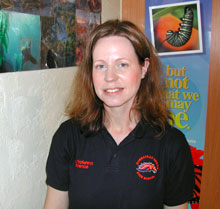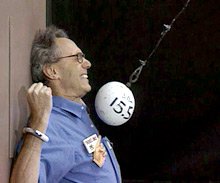Highlights for High Schools: How to Bring MIT Curriculum to Your Classroom
Educators can access the prestigious university’s free course materials on the Web.
High school teachers looking to reinforce their curriculum and knowledge base can now tap into the course materials faculty use at the Massachusetts Institute of Technology. A new online program called Highlights for High School -- part of the interdisciplinary OpenCourseWare system MIT launched six years ago -- gives educators and students free Web access to the esteemed university's introductory courses and related tools, such as Advanced Placement test preparation, video demonstrations, and lab experiments. High school teachers at any level may use these resources to supplement their lesson plans, in-class activities, homework assignments, and reading lists.

Rebekka Stone, a tenth-grade biology teacher in Homestead, Florida, says she uses Highlights for High School to increase her students' science comprehension and to introduce them to the idea of higher learning. Less than half of Homestead's students graduate, and Stone thinks using the MIT materials will encourage more of them to continue their education. She says students who once assumed college isn't an option for them have gained confidence by doing college-level work.
"At a school like ours, it's great that the kids can see, 'Oh, college isn't that scary.' It's definitely breaking down some of the barriers that the kids feel would prevent them from going to college," Stone says. Once they get a taste of MIT, she adds, they come to realize, "Maybe that's for me. I could do that!"
Highlights for High School offers links to nearly seventy introductory courses, and new material is added twice a year. To help navigate the site, we've singled out some downloads teachers can easily incorporate into high school curriculum. (MIT asks teachers using any element of Highlights for High School to give credit to the university and to the faculty member who created the work.)
AP Test Prep
MIT originally created Highlights for High School with the goal of helping students prepare for AP exams in biology, calculus, and physics. To supplement high school AP-prep classes, the Web site compiles material relevant to all three subjects, including video clips, exam questions, and practice problems. Rosemary Cenci, a teacher at Schuylerville Junior-Senior High School, in Schuylerville, New York, assigns her AP biology students practice problems from the MIT site to complete as homework.
"The questions are so cute and novel compared with the textbook examples," she notes, citing a problem set that explores heredity in a family in which some members carry that pesky gene for X-ray vision.
Cenci says the site also helps her stay current with new developments in biology. When she attended college, "molecular biology was just an up-and-coming field," she explains. "In the last thirty to thirty-five years, it has gone leaps and bounds above what I learned in college. The lectures at MIT have been such a valuable resource in helping me fill in some of the gaps in knowledge that I have."
Video Demonstrations
MIT's video demonstrations can engage students in science coursework by providing fun multimedia explanations of heady concepts. In Weightlessness During Free-Fall, for example, MIT physics professor Walter Lewin shows one principle of Newton's law of motion -- in real time and slow motion -- by leaping off his desk while holding a jug of water and by dropping a weight attached to a scale.

In Collisions in Free-fall, Lewin dons hiking shorts, a pith helmet, and sunglasses to conduct a projectile experiment by firing a ball at a monkey suspended from a pole. (No monkeys were harmed in the making of this video; the test subject is of the stuffed variety.)
Teachers can browse the demonstrations by category -- from Atomic Physics and Quantum Effects to Work, Energy, and Power -- and then show the videos in class using the RealPlayer media player. Stone says she uses the MIT videos in her classes to reinforce key concepts.
The vivid lecture included in the video Teratogens, in which biology professor Hazel Sive explains the effects of alcohol on a developing fetus, had particular resonance, Stone says, because her high school struggles with teen pregnancy. "It was a take-home message of what you don't want to be doing," she recalls. "You don't want to get pregnant in high school, but if you are pregnant, you don't want to drink."
Lab Experiments
MIT is known worldwide for its contributions to science, and now high school students may duplicate the lab work of their collegiate counterparts. The chemistry and physics labs, grouped together on the site, are downloadable as PDF files and provide detailed instructions. The files may also include color images and graphs, follow-up questions, and Microsoft Excel charts to track students' results. One electricity and magnetism experiment asks students to explore light diffraction by measuring the wavelength of a laser light, the spacing between tracks on a compact disc, and the thickness of a human hair (laser light, CD, and hair not included).
Practice Problems, Suggested Readings, and More
Teachers can find practice problems, suggested readings, and supplementary assignments for most courses offered by Highlights for High School. Michele Naber, who teaches regular and AP biology at Mission Viejo High School, in Mission Viejo, California, assigns MIT's practice problems to her students as in-class assignments and on tests. She appreciates how accessible the site is, despite its wealth of information. "It's easy to use," she notes. "I've been to some sites where they put everything on one big index page, and it takes you forever to read through it. The indexing they use on this site is very search friendly. It's easy to find a specific topic."
The site includes exams with many of the courses, particularly those dealing with science and math. Some tests and assignments include answer sets for teachers. Others do not, so that MIT professors may reuse questions for future classes.
Highlights for High School provides so much material, teachers can sometimes use it to teach an entire lesson. When Jeff Weitz, a high school physics teacher at Horace Mann School, in Riverdale, New York, had to miss class for a conference, he considered assigning his students a problem set to complete in his absence. Instead, he chose to have them watch a video lecture by the always dynamic Professor Lewin.
"He's the best sub on the planet for AP physics," Weitz reports. "Lewin discussed exactly the topic I would have, so my class didn't miss a beat. The video was just a tad longer than our class period, and I know for a fact that nearly all the kids went home and watched the end. They can't give feedback any more positive than that."